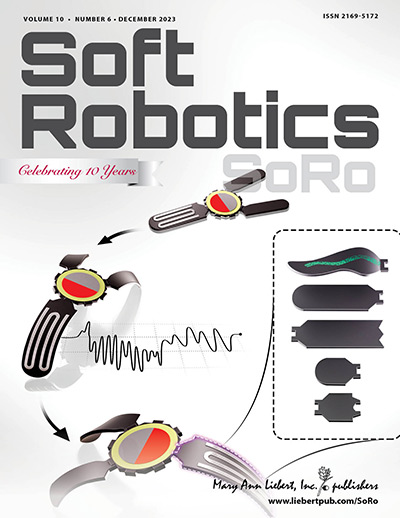An Inchworm-Inspired Fast-Moving Micro Flexible Robot for Autonomous Terrain-Adaptive Exploration.
IF 6.1
2区 计算机科学
Q1 ROBOTICS
引用次数: 0
Abstract
Soft robots with motion sensing can achieve motion feedback and monitor environmental changes. Motion sensing significantly expands the potential applications of soft robots in exploration and other fields. This study investigates an inchworm-like miniature soft robot capable of rapid locomotion and autonomous terrain-adaptive exploration. The motion is enabled by two key innovations: (1) a piezoelectric driving body that harnesses the substantial expansion-contraction deformation through an enhanced geometric nonlinearity model, overcoming limitations of conventional small-deformation theories, and (2) the adhesive forces produced by electroadhesive pads. This robot can move rapidly on various substrates, reaching a maximum speed of 1.93 body lengths per second. Additionally, the robot exhibits excellent load-bearing capacity and robustness, capable of pushing a payload of 6.8 g (8.35 times its weight of 0.814 g) and resisting strong external forces. The robot shows environmental adaptability in different terrains, such as crawling on rough terrains (including sandpaper, Ra = 10.8 μm), passing through a circular pipe with an inner diameter of 92 mm, descending a 5 mm step, ascending slopes with a 28° inclination, and traversing narrow gaps with a height of 11.5 mm (0.38 times the robot's maximum body height). Furthermore, the integration of an inertial measurement unit (IMU) system provides the robot with motion sensing capabilities, facilitating real-time position detection and environmental mapping.基于尺蠖的快速移动微柔性机器人自主地形自适应探索。
具有运动传感功能的软体机器人可以实现运动反馈和对环境变化的监测。运动传感极大地拓展了软机器人在勘探等领域的潜在应用。本文研究了一种具有快速运动和自主地形适应探索能力的寸虫型微型软机器人。该运动由两项关键创新实现:(1)压电驱动体,通过增强的几何非线性模型利用大量的膨胀-收缩变形,克服了传统小变形理论的局限性;(2)电粘合垫产生的粘附力。该机器人可以在各种基底上快速移动,最高速度可达每秒1.93个身长。此外,该机器人具有出色的承载能力和坚固性,能够推动6.8 g(其重量0.814 g的8.35倍)的有效载荷,并能抵抗强大的外力。机器人对不同地形具有良好的环境适应性,如在粗糙地形(含砂纸,Ra = 10.8 μm)上爬行,通过内径为92 mm的圆形管道,下5 mm的台阶,上倾角为28°的斜坡,通过高度为11.5 mm(机器人最大体高的0.38倍)的狭窄缝隙等。此外,惯性测量单元(IMU)系统的集成为机器人提供了运动传感能力,便于实时位置检测和环境测绘。
本文章由计算机程序翻译,如有差异,请以英文原文为准。
求助全文
约1分钟内获得全文
求助全文
来源期刊

Soft Robotics
ROBOTICS-
CiteScore
15.50
自引率
5.10%
发文量
128
期刊介绍:
Soft Robotics (SoRo) stands as a premier robotics journal, showcasing top-tier, peer-reviewed research on the forefront of soft and deformable robotics. Encompassing flexible electronics, materials science, computer science, and biomechanics, it pioneers breakthroughs in robotic technology capable of safe interaction with living systems and navigating complex environments, natural or human-made.
With a multidisciplinary approach, SoRo integrates advancements in biomedical engineering, biomechanics, mathematical modeling, biopolymer chemistry, computer science, and tissue engineering, offering comprehensive insights into constructing adaptable devices that can undergo significant changes in shape and size. This transformative technology finds critical applications in surgery, assistive healthcare devices, emergency search and rescue, space instrument repair, mine detection, and beyond.
 求助内容:
求助内容: 应助结果提醒方式:
应助结果提醒方式:


